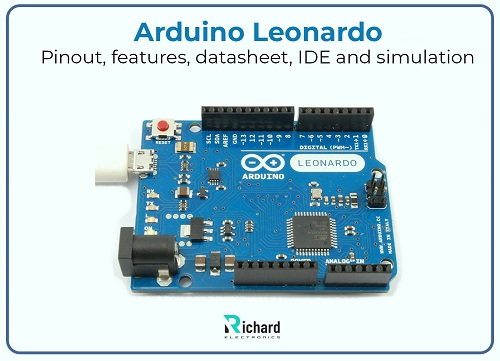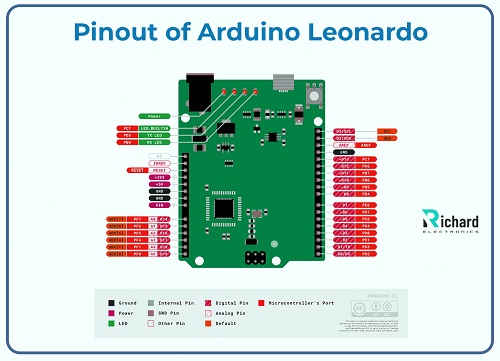Arduino Leonardo is a versatile and powerful microcontroller board that stands out for its ability to emulate a mouse or keyboard without the need for additional libraries. It features 20 digital I/O pins, with 7 of them supporting PWM output, and 12 analog input pins. Additionally, it supports communication protocols such as UART, SPI, and I2C. In this article, we will explore its history, pinout, datasheet, features, IDE, and simulation.

### History of Arduino Leonardo (A000057):
- In 2012, Arduino Leonardo was introduced in the Arduino series, expanding the family of Arduino microcontroller boards.
- Based on the ATmega32u4 microcontroller, it includes native USB support.
- It was the first Arduino board to offer native USB communication without requiring a separate USB-to-serial adapter.
- Designed for advanced projects that require direct interaction with a computer via a USB port.
- Fully supported by the Arduino IDE, making it easy to program.
- Features USB HID capabilities, setting it apart from previous Arduino boards.
- Widely used in professional prototyping and educational environments due to its versatility and unique features.
### Pinout of Arduino Leonardo:

#### Digital Pins:
- **D0-D13**: These are general-purpose digital I/O pins. D0 and D1 are used for serial communication (RX and TX), while others serve various functions.
- **PWM Output**: Pins 3, 5, 6, 9, 10, and 11 support Pulse Width Modulation.
- A detailed breakdown of the digital pins can be found in the table below.
| Number of pins | Type of pin | Name of pins / protocol | Detail |
|----------------|---------------------|-------------------------|------------------------------------------|
| D0 | Serial or digital | RX (UART) | Used for serial communication receive |
| D1 | Serial or digital | TX (UART) | Used for serial communication transmit |
| D2 | Interrupt or digital| Digital pin | Used for INT2 or digital input/output |
| D3 | Interrupt, digital, or PWM | PWM pin | Used for INT3 or pulse width modulation |
| D4 | Digital | Digital pin | General-purpose input/output |
| D5 | PWM or digital | PWM pin | Pulse width modulation output |
| D6 | PWM or digital | PWM pin | Pulse width modulation output |
| D7 | Digital | Digital pin | General-purpose input/output |
| D8 | Digital | Digital pin | General-purpose input/output |
| D9 | PWM or digital | PWM pin | Pulse width modulation output |
| D10 | PWM, digital, or SPI| PWM pin | Pulse width modulation output or SPI (SS)|
| D11 | PWM, digital, or SPI| PWM pin | Pulse width modulation output or MOSI |
| D12 | SPI or digital | Digital pin | General-purpose digital or MOSI |
| D13 | LED or digital | LED pin | Connected to onboard LED |
#### Power Pins:
| Name of pins | Protocol / type of pin | Detail |
|--------------|------------------------|----------------------------------------|
| GND | Ground pin | Used to complete circuits |
| 5V | Power supply output | Regulated through USB or external power|
| RESET | Reset pin | Used to reset the microcontroller |
| VIN | Power supply input | Input voltage 7V - 12V |
| AREF | Analog reference pin | Used for reference voltages |
| 3.3V | Power supply output | Regulated power supply output |
#### Specific Pins:
- **Interrupt pin**: Used for external interrupts.
- **Pin 13**: Built-in LED.
- **SPI**: Used for SPI communication on ICSP headers (MOSI, SCK, MISO).
- **I2C pins**: Data line (SDA) and clock line (SCL), using pins 2 and 3.
#### Analog Input Pins:
- Arduino Leonardo has 12 analog input pins (A0-A5), which can also function as digital I/O pins. They read analog inputs between 0V and 5V with 10-bit resolution.
### Datasheet of Arduino Leonardo:
The technical specifications of Arduino Leonardo are essential for understanding its capabilities and unique features. You can download the full datasheet by clicking the button below:
[Download Arduino Leonardo Datasheet](#)
Here are some key specifications:
| Parameters | Technical Specifications |
|------------------------|-------------------------------------------------|
| Microcontroller | ATmega32u4 |
| Flash Memory | 32 KB (4 KB used for bootloader) |
| Operating Voltage | 5V |
| Weight | 20 grams |
| SRAM | 2.5 KB |
| Length | 68.6 mm |
| Digital I/O Pins | 20 digital pins |
| Width | 53.3 mm |
| Input Voltage | 7V - 12V |
| PWM Pins | 7 pins from 20 digital I/O pins |
| EEPROM | 1 KB |
| Analog Input Pins | 12 pins |
| LED Pin | Pin 13 is used for built-in LED |
Arduino Leonardo is an excellent choice for developers and hobbyists looking for a powerful, flexible, and user-friendly microcontroller board. Its native USB capabilities, combined with a wide range of input/output options, make it ideal for a variety of applications, from simple projects to complex automation systems.
Sintered Alnico Magnet,Alnico Sintered Magnet,Sintered Alnico Magnets,Alnico Magnet Grades
NINGBO GAOTRON MAGNETIC INDUSTRY CO.,LTD , https://www.gaotronmagnet.com